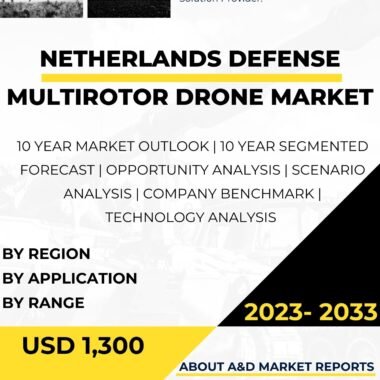Description
The India defense multirotor drone market is a rapidly expanding and critical segment within the country’s defense industry, driven by the growing demand for unmanned aerial systems (UAS) to bolster the capabilities of the Indian Armed Forces. Multirotor drones, also known as quadcopters or hexacopters, are unmanned aerial vehicles (UAVs) equipped with multiple rotors, enabling vertical takeoff and landing (VTOL) capabilities. These versatile and agile drones have found various applications in defense, ranging from surveillance and reconnaissance to target acquisition and intelligence gathering.
The India defense multirotor drone market encompasses a wide range of drone technologies, including surveillance drones, reconnaissance drones, payload delivery drones, and tactical drones. These drones are designed to meet the diverse operational requirements of the Indian Armed Forces across different terrains and environments, providing real-time situational awareness and operational advantages.
The adoption of multirotor drones in the Indian defense sector has been driven by several factors. First and foremost is the need to enhance the country’s defense capabilities and strengthen its security posture. Multirotor drones offer a cost-effective and efficient solution for aerial surveillance and reconnaissance, enabling defense personnel to monitor critical borders, coastal regions, and sensitive areas without risking the lives of soldiers.
Moreover, the India defense multirotor drone market has witnessed significant advancements in drone technologies, such as improved battery life, higher payload capacity, and enhanced data transmission capabilities. These technological advancements have enabled drones to carry sophisticated sensors, cameras, and other surveillance equipment, allowing for better intelligence gathering and target acquisition.
The Indian government’s focus on indigenization and self-reliance in defense manufacturing has been instrumental in driving the growth of the domestic defense multirotor drone market. The “Make in India” initiative, launched in 2014, aims to promote domestic manufacturing and reduce reliance on imports. As a result, Indian defense companies are actively engaged in developing indigenous multirotor drone technologies, fostering collaborations with research institutions, and investing in cutting-edge research and development.
Furthermore, the India defense multirotor drone market has witnessed collaborations with international drone manufacturers and technology providers to access global expertise and best practices. Joint ventures, technology transfers, and knowledge-sharing agreements have facilitated the integration of advanced drone solutions into India’s defense operations.
One of the primary objectives of the India defense multirotor drone market is to enhance the indigenous development and manufacturing of drones. The development of critical drone technologies contributes to the self-reliance goals of the Indian defense industry, reducing the country’s dependence on foreign suppliers.
Additionally, the adoption of multirotor drones in defense applications has been facilitated by changes in regulations governing drone operations in India. The Directorate General of Civil Aviation (DGCA) has introduced guidelines and regulations for drone operations in the country, allowing for controlled and authorized use of drones for defense and security purposes.
The India defense multirotor drone market is witnessing advancements in artificial intelligence (AI) and autonomous capabilities. These technologies enable drones to operate autonomously, make real-time decisions based on collected data, and perform complex missions with minimal human intervention. Autonomous drones have the potential to revolutionize defense operations, offering increased efficiency, reduced manpower requirements, and enhanced mission success rates.
The Indian defense forces’ focus on counter-terrorism, border surveillance, and disaster management has further propelled the demand for multirotor drones. These drones provide real-time aerial intelligence and reconnaissance, supporting rapid response and decision-making during critical situations.
The India defense multirotor drone market also faces certain challenges. One significant hurdle is the need to address airspace security concerns and prevent unauthorized drone intrusions. Ensuring the safe and secure operation of military drones in Indian airspace is critical to avoiding potential security threats and protecting sensitive areas.
Additionally, the development of robust communication and data transmission technologies is crucial for seamless connectivity between drones and ground control stations. Reliable communication links are essential for real-time data exchange, remote control, and mission execution.
Looking ahead, the India defense multirotor drone market is expected to witness sustained growth as the country continues to modernize its defense capabilities and prioritize indigenization. The government’s commitment to enhancing the domestic defense industry, investing in research and development, and fostering collaboration with international partners will be instrumental in driving the adoption of advanced drone technologies and expanding the applications of multirotor drones in defense operations.
In conclusion, the India defense multirotor drone market is a vital enabler of the country’s defense preparedness, contributing to the modernization and operational effectiveness of the Indian Armed Forces. With a focus on indigenization, research, and collaboration, the Indian defense multirotor drone market is poised to become a significant contributor to the country’s defense industry, supporting national security and fostering technological self-reliance. As India’s defense needs continue to evolve, the demand for advanced multirotor drone technologies will remain at the forefront of the country’s defense modernization efforts.




